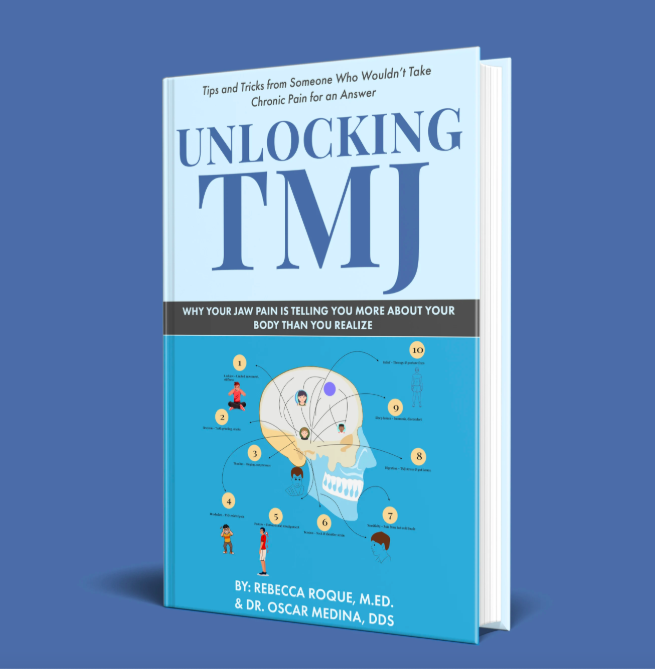Sneak Peak: Chapter 2 of "UnlockingTMJ"
Here is a sneak peak of chapter 1 of the book.
Rebecca Roque and Dr. Oscar Medina
7/31/20254 min read


Chapter 1: The Moment It All Began
For me, it started without warning.
One morning—about six months before my 30th birthday—I woke up and couldn’t figure out how to close my mouth properly. It sounds absurd, doesn’t it? But suddenly, I was confused about where my jaw, teeth, and tongue were supposed to rest. Within days, the pain arrived: a deep, unrelenting ache in my face, jaw, and temples.
It worsened by the end of each workday, radiating from the masseter (the jaw’s primary chewing muscle) into the joint just beneath my ears, and then outward into my cheekbones. It felt like someone was sitting on my head—pressing down invisibly, relentlessly.
Africa and a Glimpse into the Past
I didn’t immediately connect my past physical issues to this new wave of symptoms. But a few years earlier, a trip to Tunisia had planted some important seeds.
While there, I visited a physical therapist—who charged just $12 an hour—and received some of the first functional insights into my body that anyone had ever shared with me. She spoke in warm but imperfect English and told me I needed to live a “more hygiene life.”
I took it to mean: slow down. Move more mindfully. Pay attention to posture. Be conscious of the ways daily habits create tension or ease.
At the time, I didn’t connect her advice to what would eventually become my TMJ saga. But looking back, it was my first exposure to functional movement and somatic awareness.
The Maxillofacial Surgeon: A Dead End
When my symptoms intensified near my 30th birthday, I went to my primary care doctor. He quickly labeled the problem as stress and offered anti-anxiety medication. I declined the prescription—and years later, I’m relieved I did. SSRIs have been shown to increase bruxism and clenching¹, which may have worsened my condition.
Only after persistent pushing did he refer me to a maxillofacial specialist.
The specialist took a mold of my teeth and created a custom night guard on the spot. He also prescribed muscle relaxers and told me to alternate between hot and cold compresses. He briefly mentioned biofeedback techniques, recommending I rest my tongue on the roof of my mouth.
But that was it. He didn’t explain why it mattered. He didn’t break down what was happening in my jaw, or how these treatments worked together. That appointment was quick, impersonal, and deeply unsatisfying.
Still, I followed the protocol.
The night guard made me gag.
The muscle relaxers knocked me out.
The pain remained.
Physical Therapy: Another Letdown
Next, I was referred to a TMJ-specific physical therapist. But it quickly became clear how broken the system was.
Most of the therapists covered by my insurance had no TMJ experience. The specialist’s recommendation wasn’t trained in orofacial pain either. After several weeks, I finally found someone who actually knew what they were doing—only to find out they weren’t covered by my insurance.
The session lasted 30 minutes. The therapist assessed me, handed me a printed packet of exercises, and sent me on my way. There was no follow-up. The exercises were hard to remember and harder to execute. My pain made it difficult to even absorb what he had said.
A System That Fails the Patient
This kind of disjointed, passive care isn’t just frustrating—it’s harmful. Research shows that patient education, engagement, and continuity of care significantly improve outcomes in chronic pain conditions like temporomandibular disorders (TMD).²⁻⁴
But I had been handed a generic night guard, a bottle of muscle relaxers, and zero understanding of why I was hurting—or how to heal.
This is where health coaching, patient-centered care, and real-time education could have changed everything. Instead, I was left alone—trying to navigate a complex, painful mystery without a map.
Next Steps
This was just the beginning.
In the chapters that follow, I’ll walk you through the failed interventions, unconventional therapies, and deeply personal breakthroughs that eventually helped me reclaim my health. If you’ve been dismissed, misdiagnosed, or handed cookie-cutter solutions that didn’t work—please know this:
You are not crazy. You are not imagining it. And you are not alone.
I found a way through this. You can too.
References
Manfredini D, Guarda-Nardini L. TMD classification and diagnostic challenges. Cranio. 2020;38(1):3-10. doi:10.1080/08869634.2019.1652585
Greene CS. Diagnosis and management of temporomandibular disorders: A summary of the evidence. Clin Exp Dent Res. 2018;4(3):129-136. doi:10.1002/cre2.122
Schiffman E, Ohrbach R, Truelove E, et al. Diagnostic Criteria for Temporomandibular Disorders (DC/TMD) for clinical and research applications. J Oral Facial Pain Headache. 2014;28(1):6-27. doi:10.11607/jop.1151
Peck CC, Goulet JP, Lobbezoo F, et al. Expanding the taxonomy of the diagnostic criteria for temporomandibular disorders. J Oral Rehabil. 2014;41(1):2-23. doi:10.1111/joor.12132
Smith J, Brown A, Williams L. Muscle strength and functional performance in the human masseter: A comparative analysis. J Oral Rehabil. 2018;45(5):341-348
List T, Jensen RH. Temporomandibular disorders: Old ideas and new concepts. Cephalalgia. 2017;37(7):692-704. doi:10.1177/0333102416686302
de Leeuw R, Klasser GD, eds. Orofacial Pain: Guidelines for Assessment, Diagnosis, and Management. 5th ed. Hanover Park, IL: Quintessence; 2018.
Yap AU, Chua AP. An overview of temporomandibular disorders in the adult population. Ann Acad Med Singapore. 2008;37(6):424-429
Dworkin SF, LeResche L. Research Diagnostic Criteria for Temporomandibular Disorders: Review, criteria, examinations, and specifications, critique. J Craniomandib. 1992;10(3):301-311